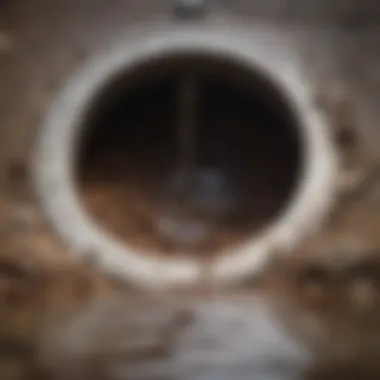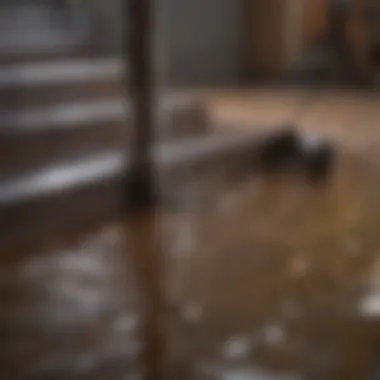Understanding and Resolving Stubborn Clogged Drains


Intro
Clogged drains are a common yet frustrating issue for homeowners. Often, they signify deeper problems in plumbing systems. Understanding the reasons behind these stubborn blockages is crucial for effective treatment and prevention.
This article will elucidate the main causes of clogged drains and how to approach their resolution. Additionally, it will offer prudential advice on when to apply DIY methods versus when to enlist professional help. This knowledge will not only aid in maintaining plumbing efficiency but also in extending the lifespan of your home’s infrastructure.
By gaining insight into the anatomy of drainage systems and identifying potential pitfalls, homeowners can feel empowered to implement solutions.
"A proactive approach to plumbing issues can save time, money, and unnecessary stress."
In this guide, we will unpack various strategies for tackling clogged drains. From understanding the triggers to offering step-by-step solutions, we aim to equip you with the tools needed for effective home maintenance.
Preamble to Clogged Drains
Clogged drains are a common yet persistent issue in many households. Understanding the nature of clogged drains is crucial for homeowners, as it offers insights into effective maintenance and timely intervention. This section explores the definition of clogged drains, along with their significance in home upkeep.
Definition and Overview
A clogged drain occurs when water fails to flow freely through the plumbing system, obstructed by various materials. The obstruction can arise from numerous sources, such as hair, soap scum, food particles, or foreign objects. In severe cases, tree roots may invade the drainage system, blocking the passage even more. Identifying the type and location of the clog is essential for effective resolution.
Significance in Home Maintenance
The significance of addressing clogged drains cannot be overstated. Blocked plumbing not only impedes daily functionality but also poses potential health risks. Standing water in sinks or tubs can become a breeding ground for bacteria. Moreover, ignoring clogged drains can lead to extensive and costly repairs down the line. Regular maintenance helps prevent such obstructions and ensures smooth functionality of the home’s plumbing systems.
Homeowners must consider that prevention is often more cost-effective than dealing with the consequences of neglected plumbing.
In summary, understanding clogged drains is fundamental for homeowners to maintain a healthy and functional living environment. Proper insight into common issues and preventive measures enhances home care and avoids complications.
Common Causes of Clogged Drains
Understanding the common causes of clogged drains is fundamental for homeowners who seek to prevent and resolve plumbing issues effectively. Each household experiences drain blockages occasionally, but knowing the specific elements that lead to these problems can save time, money, and frustration down the line. The significance lies in recognizing these triggers, which allows for practical prevention strategies and DIY solutions to be implemented before problems escalate.
Accumulation of Hair and Soap Scum
Hair is a frequent culprit in bathroom drains. When washing hair or during daily grooming, loose strands often wash down the sink or shower. As hair combines with soap scum, it forms a dense mass that can easily obstruct water flow. This detritus typically gathers in the P-trap, where the water curvature is located. Regularly cleaning the drain and using a drain cover can reduce the amount of hair that enters the plumbing system.
Food Debris and Grease Buildup
In kitchen sinks, food particles and grease are leading contributors to clogged drains. After meals, remnants of food are often washed down the sink. Over time, grease can accumulate, solidify, and combine with these particles, forming a thick blockage. To combat this, it is advisable to scrape plates before washing them. Utilizing a strainer to catch larger pieces of food can also help minimize buildup.
Foreign Objects in Drainage Systems
Sometimes, it is not organic matter that causes clogs, but foreign objects. Items such as toys, utensils, or even excessive amounts of toilet paper can inadvertently make their way into the drainage system. When this occurs, a significant obstruction may form. Identifying and removing these objects might be feasible, but in complex cases, professional help may be necessary to avoid further damage.
Tree Root Intrusion
Tree root intrusion is a less common yet serious cause of clogged drains, particularly in older homes. Roots from nearby trees can invade sewer lines, causing blockages. This problem often manifests as slow drainage or recurring clogs. Homeowners should monitor their yards and, when needed, seek plumbing inspections. Removing trees or roots working into pipes may take professional intervention, making early detection crucial to prevent extensive plumbing issues.


Understanding these causes will help prevent future clogs and maintain a smooth drainage system.
Symptoms of Stubborn Clogged Drains
Understanding the symptoms of stubborn clogged drains is crucial for homeowners as it allows for early detection and corrective actions. Ignoring these signs can lead to more severe plumbing issues, resulting in costly repairs. Thus, recognizing the indicators is the first step toward effective maintenance of your plumbing system. Being aware of these symptoms enhances the ability to prevent bigger problems, ensuring a smoother life in your home environment.
Slow Drainage in Sinks and Bathtubs
One of the most common symptoms of a clogged drain is slow drainage. When sinks or bathtubs take longer to empty than usual, it is often a clear signal that a blockage is present. This condition can arise either from minor clogs, such as hair or soap scum buildup, or more serious issues deeper in the plumbing. A timely response is essential; otherwise, the situation can worsen, leading to complete blockage.
Homeowners should note that slow drainage can also indicate problems in other areas of the plumbing. For example, multiple fixtures draining slowly may suggest a more systemic issue within the drainage system, requiring investigation.
Unpleasant Odors
Another critical sign of clogged drains is the presence of unpleasant odors emanating from sinks, bathtubs, or even floor drains. These odors typically arise from stagnating water mixed with organic matter and waste. The buildup often leads to decay and can be quite foul. The smell might be more noticeable after the use of hot water, which can break down some of the buildup and release trapped scents into the air.
Addressing unpleasant odors promptly is necessary for maintaining a healthy living environment. Ignoring these smells may lead to unhygienic conditions, potentially impacting both comfort and health within the home. Regular inspections and cleanings can help maintain a pleasant atmosphere.
Gurgling Sounds from Pipes
Gurgling sounds from pipes can serve as an alarming indication of clogged drains. Such noises occur when air gets trapped in the drainage system due to a blockage, causing the water to struggle against the obstruction. This symptom not only signifies that there is a clog but can also reflect deeper issues in the drainage system that may need immediate attention.
If gurgling persists, it could ultimately result in harmful plumbing failures. Homeowners should take these sounds seriously. Practicing regular checks and addressing issues as they arise ensures a more efficient plumbing system.
Recognizing these symptoms aids homeowners in taking proactive steps toward keeping their drains clear and functional.
Understanding these three key symptoms — slow drainage, foul odors, and gurgling sounds — is essential for effective plumbing maintenance. For a cleaner home and to avoid future complications, awareness and timely action are vital.
Preventive Measures for Clogged Drains
Taking steps to prevent clogged drains is essential for maintaining a plumbing system in optimal condition. Clogs can lead to extensive repairs and costly fixes, making prevention far more cost-effective than resolution. Identifying good preventive measures will help homeowners reduce the risk of encountering persistent drainage problems.
Regular Cleaning and Maintenance
Performing regular cleaning and maintenance of waste disposal systems is vital. This includes clearing away visible debris from sink and bathtub drains, as well as cleaning nearby areas. Using a mixture of hot water and a suitable cleaning solution periodically can also aid in breaking down buildup before it becomes a more significant issue. It is advisable to check drain traps regularly to ensure they are free from hair, soap, and other potential clogs.
The most effective cleaning often employs a combination of methods. For instance, pouring boiling water down the drain followed by a commercial cleaner can help dissolve stubborn grime. Moreover, engaging in seasonal inspections can highlight potential issues before they escalate into severe blockages, further preserving the integrity of the plumbing system.
"Basic maintenance will save time and ensure peace of mind."
Proper Disposal of Waste Materials
Disposing of waste materials appropriately is crucial in avoiding clogs. Educating all household members on what should and should not be put down the kitchen sink can prevent food debris from accumulating. Items like grease, coffee grounds, and fibrous vegetables should be discarded in a trash can instead of being washed down the drain.
In bathrooms, the context is similar. Flushing anything other than human waste and toilet paper can lead to complications. Feminine hygiene products, cotton swabs, and dental floss should never be flushed, as they do not break down easily and cause blockages. Instead, they should be disposed of in the bin to ensure smoother plumbing operation.
Preventive Drain Covers


Investing in preventive drain covers can dramatically increase the longevity of a plumbing system. These simple devices can trap debris before it enters the actual plumbing, minimizing the chances of clogs forming. They come in various styles and sizes, suitable for different types of drains.
Regular upkeep of drain covers is also important. Cleaning and replacing these covers as necessary ensures they perform optimally. By using these preventative tools, homeowners can enjoy cleaner, lower-maintenance drains and a more efficient plumbing system overall.
DIY Solutions for Unclogging Drains
Many homeowners face clogged drains at some point. Understanding DIY solutions for unclogging drains can be a valuable asset. Not only can these methods save time and money, but they also empower individuals to take charge of their home maintenance. Tackling minor blockages on your own can prevent larger issues that require professional attention. The ability to use simple tools and common household items effectively can lead to a more efficient plumbing system.
Using Plungers Effectively
Using a plunger is a well-known and effective technique for unclogging drains. This device relies on suction to remove blockages. It is especially useful in sinks and toilets. To use it effectively, follow these steps:
- Select the Right Plunger: You should use a cup plunger for sinks and a flange plunger for toilets.
- Create a Good Seal: Position the plunger over the drain opening and ensure it covers it completely. This helps create suction.
- Push and Pull: Use steady force in a vertical motion. Push down firmly, then pull up quickly. Repeat several times.
- Check the Result: After plunging, see if the water drains properly. If not, try again or move to another method.
A good plunge can often dislodge stuck debris without the need for chemicals.
Implementing Baking Soda and Vinegar Method
The baking soda and vinegar method is a great choice for those seeking a natural solution to clogged drains. This approach avoids harsh chemicals, making it a more environmentally friendly option. Here’s how to use it:
- Remove Excess Water: If the sink is filled with water, try to drain some.
- Pour Baking Soda: Add about one cup of baking soda directly into the drain.
- Add Vinegar: Follow it with one cup of vinegar, and quickly cover the drain. The reaction will help dissolve the clog.
- Wait: Allow the mixture to sit for approximately 30 minutes. In some cases, waiting longer can yield better results.
- Flush with Hot Water: After the wait, flush the drain with hot water to remove any remaining debris.
This method works best for slow drains clogged with organic materials, such as hair and soap scum.
Manual Removal of Clogs
Sometimes, blockages require a more hands-on approach. Manual removal can be messy but effective for clearing stubborn clogs. Here’s how to proceed:
- Gather Tools: You will need gloves, a bucket, and possibly a snake or wire hanger.
- Access the Drain: Remove the drain cover if applicable. This will provide direct access to the clog.
- Use a Snake: Insert a plumbing snake into the drain. Turn it clockwise to latch onto the clog and pull it out.
- Remove Visible Debris: If you can see the blockage, remove it with gloved hands. Ensure you get all materials, as leftover bits can cause future clogs.
- Reassemble: Once cleared, put the drain cover back, and run water to check if it drains well.
By applying these DIY methods, homeowners can often resolve minor drain issues quickly and effectively without professional help.
When to Consult a Professional Plumber
Understanding when to call a professional plumber is crucial in maintaining the health of your plumbing system. Although several DIY methods may suffice for minor clogs, certain situations demand expert intervention. Recognizing the signs of severe plumbing issues can save homeowners from extensive damage and expensive repairs.
Persistent Blockages
If you encounter drain blockages that reappear shortly after clearing them, this indicates a more serious issue. Persistent clogs often stem from an accumulation of debris deep within the drainage system. These blockages may not respond to typical DIY unclogging techniques. If you find that plungers and homemade solutions fail to restore proper function, it is advisable to consult a professional plumber. Experts utilize advanced techniques, like hydro jetting, to clear stubborn blockages without damaging your plumbing.
Signs of Pipe Damage
Sometimes, clogs are not just a result of blockages but can signify underlying pipe damage. Look for warning signs such as:
- Water leaks around joints: This may suggest cracked or broken pipes.
- Low water pressure: Reduced flow may point to larger problems.
- Discolored water: Rust or other particles may indicate corrosion.
In such cases, a professional plumber can conduct a thorough inspection, assess the damage, and recommend necessary repairs or replacements. Ignoring these signs may lead to significant water damage in your home.


Frequent Drain Issues
If you experience drain problems frequently, it is wise to seek professional assistance. Recurrent clogs can indicate faulty plumbing or deeper concern within your system. A seasoned plumber can perform a comprehensive evaluation, identifying any underlying issues that are causing these frequent blockages.
Regular usage of drains should not lead to persistent problems. Frequent drain issues require expert insight to prevent further complications.
In a nutshell, timely consultation with a professional plumber can help you navigate complex plumbing issues. This step ensures you maintain your home's integrity and avoid potentially costly repairs in the future.
Technology in Plumbing Solutions
The role of technology in plumbing has grown significantly in recent years. Innovations in tools and equipment have directly impacted the ability to manage clogged drains and overall plumbing maintenance. The integration of advanced technology not only helps in effectively addressing drainage issues but also assists in proactive preventive measures. This section delves into the importance of technology in plumbing solutions, focusing on the tools and inspection methods that enhance plumbing performance.
Preventive Maintenance Tools
Preventive maintenance tools are essential for homeowners who wish to avoid major plumbing disasters. By employing these tools regularly, one can greatly reduce the risk of stubborn clogs. Here are some key tools everyone should consider:
- Drain Snake: This flexible tool can reach deep into pipes to dismantle tough clogs.
- High-pressure Water Jet: Effective for flushing away stubborn debris that other methods cannot reach.
- Chemical Drain Cleaners: Specialized formulas can dissolve specific types of clogs but should be used with caution.
- Drain Auger: A more specialized form of a drain snake, useful for tough blockages.
Utilizing these tools can provide immediate results and also serve as a proactive measure in maintaining clear drainage systems. Regular use of preventive maintenance tools can significantly extend the life of household plumbing.
Drain Inspection Cameras
Drain inspection cameras represent a leap forward in the way homeowners can diagnose plumbing issues. These cameras are equipped with lights and a flexible cable that allows them to travel through pipe systems. The images captured can reveal:
- Location of Blockages: Pinpointing the exact site of a clog is essential for effective remediation.
- Pipe Condition: Homeowners can assess the health of their pipes, looking for cracks or corrosion.
- Tree Root Intrusion: Root systems can cause significant problems, and cameras can easily identify such issues.
Using drain inspection cameras not only saves time but also reduces the need for invasive digging or extensive repairs. Homeowners gain a comprehensive view of their plumbing systems, allowing for informed decisions moving forward.
Technology challenges traditional methods and provides new solutions for plumbing problems, ensuring a smarter approach to home maintenance.
In summary, advancements in plumbing technology benefit homeowners by improving the ability to prevent and resolve clogged drain issues. It's clear that investing in these technologies can lead to more efficient home maintenance, ultimately saving time and money.
Closure
The topic of drainage maintenance is critical for any homeowner aiming to sustain an efficient plumbing system. In this article, we delved into the causes, preventive measures, and solutions for stubborn clogged drains. These systems may seem simple, yet they require significant attention.
Understanding how to manage your drains can prevent disastrous plumbing issues in the future. By implementing proactive strategies, such as regular cleaning and proper disposal of waste, you reduce the likelihood of clogs. Recognizing when to adopt DIY techniques or when to seek professional guidance is equally essential.
Investing time and effort into maintaining your drainage infrastructure not only guarantees optimal functionality but also enhances the longevity of the pipes.
Recap of Best Practices
- Regular Maintenance: Schedule cleaning sessions every few months.
- Use Drain Covers: Protect your drains from hair and other debris.
- Proper Disposal Methods: Avoid throwing food scraps or grease into the sink.
- DIY Unclogging: Utilize methods like plungers and baking soda/vinegar for minor blockages.
- Call Professionals: When faced with persistent issues or signs of pipe damage, consult an expert.
These best practices can significantly reduce the occurrence of stubborn clogs and maintain your plumbing system's health efficiently.
Final Thoughts on Home Care
Caring for your home's plumbing may seem inconvenient, yet it pays dividends in the long run. Consider it an integral part of homeownership. A well-functioning drainage system enhances not only the quality of your living environment but also protects your property value.
Pay attention to warning signs like slow drainage or unpleasant odors. Such early detection can save you from more significant problems down the line. By integrating preventive measures into your home care routine, you can ensure that your plumbing systems remain in good working order, prolonging their lifespan and maximizing your comfort.
A diligent homeowner is a satisfied homeowner.
Ultimately, knowledge about managing clogged drains helps you make informed decisions. Your plumbing deserves attention, so give it the care it requires.







